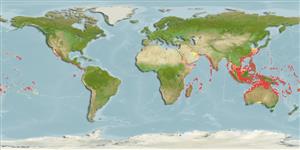>
Eupercaria/misc (Various families in series Eupercaria) >
Labridae (Wrasses) > Xyrichtyinae
Etymology: Iniistius: Latin, in = in + Greek, istion = sail.
More on author: Valenciennes.
Environment: milieu / climate zone / depth range / distribution range
Ecologia
marino associati a barriera corallina; distribuzione batimetrica 1 - 100 m (Ref. 1602), usually 20 - ? m (Ref. 9710). Tropical; 24°C - 28°C (Ref. 27115); 30°N - 30°S
Indo-Pacific: Red Sea and East Africa to the Society Islands, north to southern Japan and Hawaii, south to the Lord Howe Island. Eastern Pacific: Gulf of California to Panama and the Galapagos Islands (Ref. 5227).
Size / Peso / Age
Maturity: Lm ? range ? - ? cm
Max length : 42.0 cm TL maschio/sesso non determinato; (Ref. 97145)
Spine dorsali (totale): 9; Raggi dorsali molli (totale): 12-13; Spine anali 3; Raggi anali molli: 12 - 13. Identified by the dark vertical bar below the eye. Usually with 5 dark bars when adult and belly of female turns red. Juveniles with black anal fin and two large ocelli, thinly edged with white, in dorsal fin (Ref. 48636). First two dorsal spines form a separate fin. Juveniles this fin forms a long, bannerlike filament but shortens with age (Ref. 37816).
Usually solitary in lagoon and seaward reef areas with fine to loose, coarse sand bottoms (Ref. 1602). Juveniles sometimes in shallow estuaries (Ref. 48636). Adults rare in less than 20 m (Ref. 9710). Benthic and benthopelagic (Ref. 58302). Dives into sand to sleep safely at night or to hide when alarmed (Ref. 9311, 90102). Feed on hard-shelled invertebrates, including mollusks and crustaceans (Ref. 9311). Juveniles mimic drifting dead leaves by holding the elongate detached front part of dorsal fin forward over head. Good to eat, flesh very white (Ref. 7364). Minimum depth reported from Ref. 27115.
Life cycle and mating behavior
Maturità | Riproduzione | Deposizione | Uova | Fecundity | Larve
Distinct pairing during breeding (Ref. 205).
Randall, J.E., G.R. Allen and R.C. Steene, 1990. Fishes of the Great Barrier Reef and Coral Sea. University of Hawaii Press, Honolulu, Hawaii. 506 p. (Ref. 2334)
IUCN Red List Status (Ref. 130435)
Human uses
Pesca: commerciale; Pesce da pesca sportiva: si; Acquario: Commerciale
Informazioni ulteriori
BibliografiaAcquacolturaProfilo di acquacolturaVarietàGeneticaElectrophoresesEreditarietàMalattieElaborazioneNutrientsMass conversion
Strumenti
Special reports
Download XML
Fonti Internet
Estimates based on models
Preferred temperature (Ref.
123201): 24.2 - 29, mean 27.8 °C (based on 1216 cells).
Phylogenetic diversity index (Ref.
82804): PD
50 = 0.5000 [Uniqueness, from 0.5 = low to 2.0 = high].
Bayesian length-weight: a=0.01023 (0.00397 - 0.02640), b=3.06 (2.84 - 3.28), in cm total length, based on LWR estimates for this (Sub)family-body shape (Ref.
93245).
Trophic level (Ref.
69278): 3.5 ±0.46 se; based on food items.
Resilienza (Ref.
120179): Medio, tempo minimo di raddoppiamento della popolazione 1.4 - 4.4 anni (Preliminary K or Fecundity.).
Fishing Vulnerability (Ref.
59153): Low to moderate vulnerability (32 of 100).
Nutrients (Ref.
124155): Calcium = 40.6 [24.7, 63.2] mg/100g; Iron = 0.54 [0.32, 0.96] mg/100g; Protein = 18.5 [15.7, 20.7] %; Omega3 = 0.146 [0.101, 0.214] g/100g; Selenium = 37 [24, 60] μg/100g; VitaminA = 95.6 [31.2, 328.0] μg/100g; Zinc = 1.26 [0.92, 1.92] mg/100g (wet weight);
